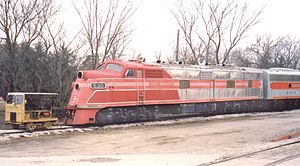EMD E series
The EMD-E-Series , English EMD E-unit or E-series, is a series of diesel locomotives for passenger trains from the US locomotive builder General Motors Electro-Motive Division (EMD). 1,314 locomotives of this series were from May 1937 to December 1963 in the EMD workshops in La Grange, Illinois produced, of which 210 copies as a leader baseless B units. This series was one of the first large diesel locomotives to be a long-term commercial success.
The term E-Series is originally derived from the used 1800 (English: e ighteen hundred) hp = 1.300 kW strong diesel engines from. The maximum speed of these locomotives was between 130 and 160 km / h, depending on the gear ratio.
Models
| EA / EB | 6 A units | 6 B units | Baltimore and Ohio Railroad |
| E1 | 8 A units | 3 B units | Atchison, Topeka and Santa Fe Railway |
| E2 | 2 A units | 4 B units | jointly by UP , C&NW and SP for the City of San Francisco and City of Los Angeles streamlines |
| E3 | 16 A units | 2 B units | ATSF (1 A, 1 B), ACL (1 A), RI (2 A), FEC (2 A), KCS (2 A, + ex EMD demonstration locomotive A), C&NW (4 A), MP (2 A) and UP (1 A, 1 B) |
| E4 | 14 A units | 5 B units | Seaboard Air Line Railroad |
| E5 | 11 A units | 5 B units | Chicago, Burlington and Quincy Railroad |
| E6 | 92 A units | 26 B units | various railway companies |
| E7 | 428 A units | 82 B units | various railway companies |
| E8 | 421 A units | 39 B units | various railway companies |
| E9 | 100 A units | 44 B units | various railway companies |
Due to the USA entering the war in World War II and the associated restriction of locomotive construction to freight train locomotives , relatively few examples of the first E-series models were produced. Only with the E6 and the following series were significant numbers achieved. However, the E series never reached the numbers of the F series freight locomotives offered in parallel .
construction
In order to achieve an output of 1,800 HP per locomotive with the diesel engines available at the time , two machine systems had to be installed. The earlier EA through E2 models used the 900 hp (700 kW) Winton 201A engine. The motor 12-567 developed by EMD was available for models E3 to E9. The first number denotes the number of cylinders (12), the second the displacement per cylinder in cubic inches . The 12-567A engines used in the E3 to E7 models developed 1,000 hp (750 kW). In the E8, the EMD 567B, increased to 1,125 hp, was used, while the 567C unit of the E9 already produced 1,200 hp.
Due to the use of two machine systems, the installation of two three-axle bogies was necessary. However, only two driven axles per bogie were required to transmit power between the wheel and the rail . For this reason, the vehicles were designed with the relatively rare wheel arrangement (A1A) (A1A).
literature
- Brian Solomon: EMD Locomotives. Voyageur Press, MBI Publishing Company Minneapolis, MN 2006 ISBN 978-0-7603-2396-0 .
